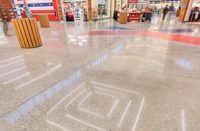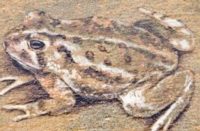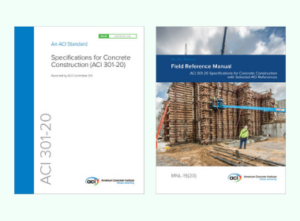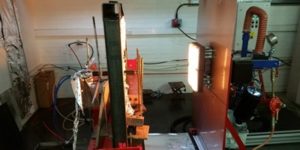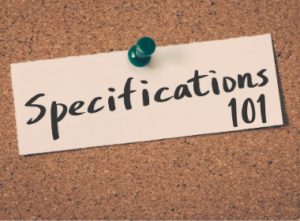ST115 is a new standard for the concrete polishing industry that was adopted in fall 2013 by the Concrete Sawing and Drilling Association (CSDA). The standard explains in detail how to measure the texture of a concrete surface by using a texture meter.
The standard assigns a numerical texture-grading code to the finish so the design community and end users alike can begin to have a more structured conversation about the quality and sustainability of a polished concrete surface. It can also be used to determine if steps in the polishing process were skipped or avoided.
The standard covers encountering surfaces that contain a lot of flaws, rollout (when sand is pulled from the matrix of concrete with an abrasive tool during the grinding or polishing process) and voids. It looks at how to properly honor these character flaws in the surface and get a reliable reading. ST115 also equips the processor of the polished floor system with a valuable device that enables them to monitor the refinement process of a specific tool in a multiple-tooling system and measure the surface of the concrete after the tool’s work is completed. This allows the processor to monitor the quality of abrasives he is using from his current supplier and gives him the ability to compare similar abrasives from competitive manufacturers.


ST115 is a very detailed map of surface measurement that will catch any minor adjustment or deviations from the surface. The quantitative surface refinement number is always accurate and does not vary depending on the type of polish guard or sealer that was used.
It has always been important for polished concrete to have a quantifiable standard for the level of finish being produced. The first best-practices documents written in our industry broke out the various levels of grinding. Not only did the polishing industry follow the refinement process, it also understood that sequencing steps would need to follow the selected starting grit in order to get a clean, scratch-free finish. The polished floors that were produced with this basic concept provided a consistent finish and a relatively predictable outcome.
When the industry evolved into a completely dry polishing system as an alternative way to polish concrete, it identified a similar progressive sequence of steps that also focused on a high degree of refinement and produced a comparative and predictable finish.
Many of the discussions early on about the quality of finishes were settled by using a gloss meter. This quantitative measurement gave the end user a quantifiable standard to write into a polishing specification, and the facility was virtually guaranteed to get two things at once. The first was a highly processed and refined floor, and the second was a gloss level that was easy to achieve by selecting resin-bonded abrasive tools. You could increase the gloss level if higher progressive grits were run over the last polishing grit selected.
The problem is that over the past six to seven years, end users have been experiencing sustainability issues that they had never encountered before.

In today’s polished concrete world, we see a wide range of systems and equipment, and just as many types of specially formulated chemicals and abrasives for the polishing industry, with only one quantitative standard of evaluation, the gloss meter. No fault to the gloss meter, but some of the topical concrete polishing sealers have the ability to cover heavy metal-bond scratches, change the texture from rough to smooth, and even increase the gloss number on projects that were tested with failing readings. These “tricks of the trade” have caused end users to spend much more than expected on maintenance systems to keep their floors looking as good as the day they were finished. These floors are not holding their own. Why? Surface refinement is ignored in processes that endorse skipping progressive steps and not properly chasing the scratch out of the surface.
Function and sustainability are the positive attributes of polished concrete, so our industry is working hard to provide clear language about evaluating the quality of a polished concrete surface beyond the ability to record scattered light with a gloss meter.
Over the past two years, I have had the honor of being the chair of a group of 16 experts in the fields of surface metrology, concrete finishing, concrete repair and concrete mix designs, representing five major industry associations (the American Concrete Institute, ASTM International, American Society of Mechanical Engineers, International Concrete Repair Institute and CSDA) and representing five continents. We assembled the concrete industry’s first standard for quantifying a concrete surface by accurately reading its texture and assigning the proper designation code or STG (Surface Texture Grade). This is the first standard of its kind for the concrete industry — but not a new standard to other industries. The metal and plastic finishing industries adopted similar standards more than 50 years ago because they both experienced the same challenges with interpretation and processing techniques.
The one thing that will always remain constant and true about surface finishing is that any surface with a high degree of refinement can produce a byproduct called gloss. You can never have a highly refined floor without gloss, ever. ST115 is not biased, does not take sides, does not allow cheating, and does not favor one polished system over another (such as wet over dry). It only reads the real surface.
Used in conjunction with gloss meters and DOI (distinction of image) meters, ST115 tells a compelling story about the quality of a finish and changes the current discussion of “How long is it going to last?” to “How long can it last?”
A PDF of the new Standard ST115 can be found online at: www.csda.org/displaycommon.cfm?an=1&subarticlenbr=479

